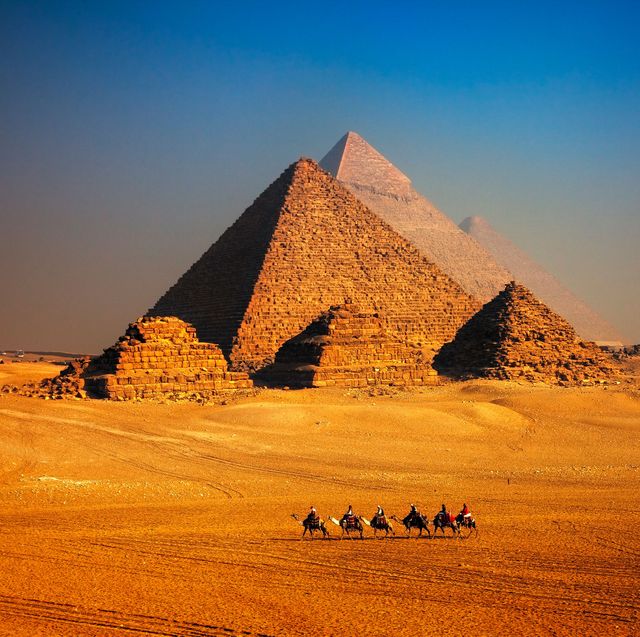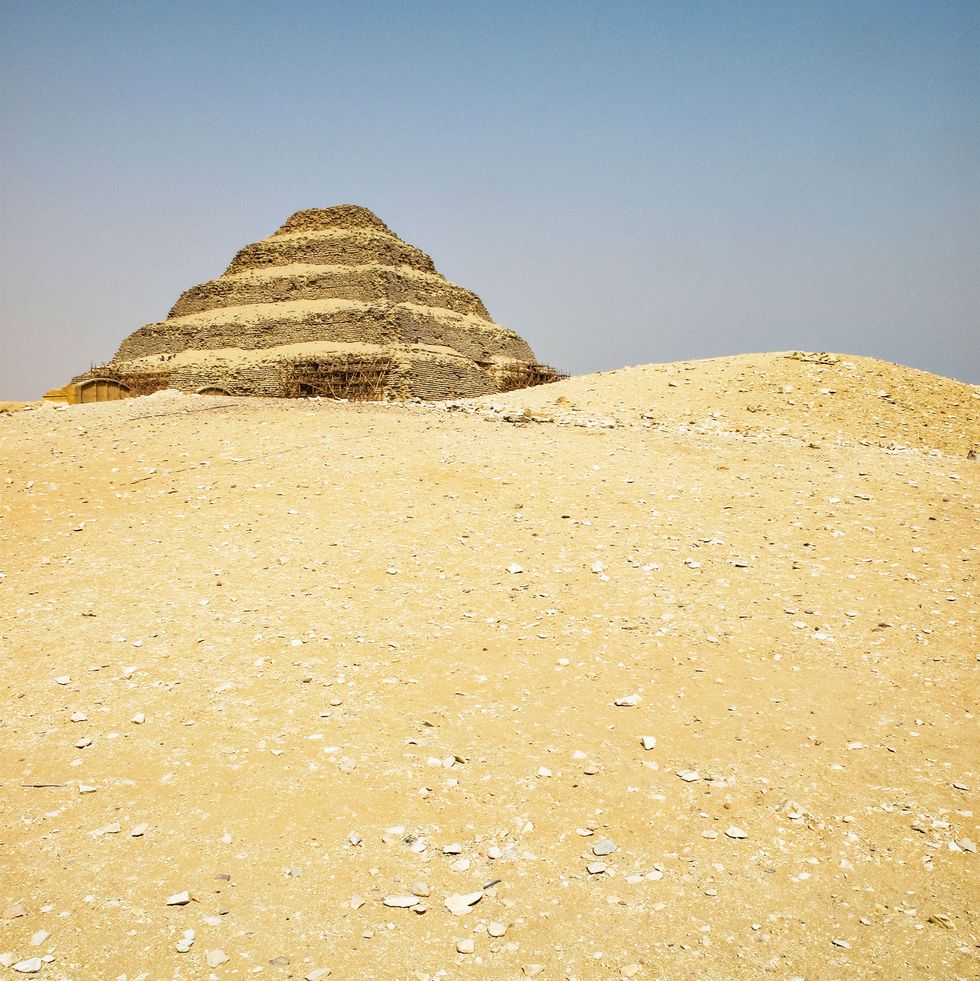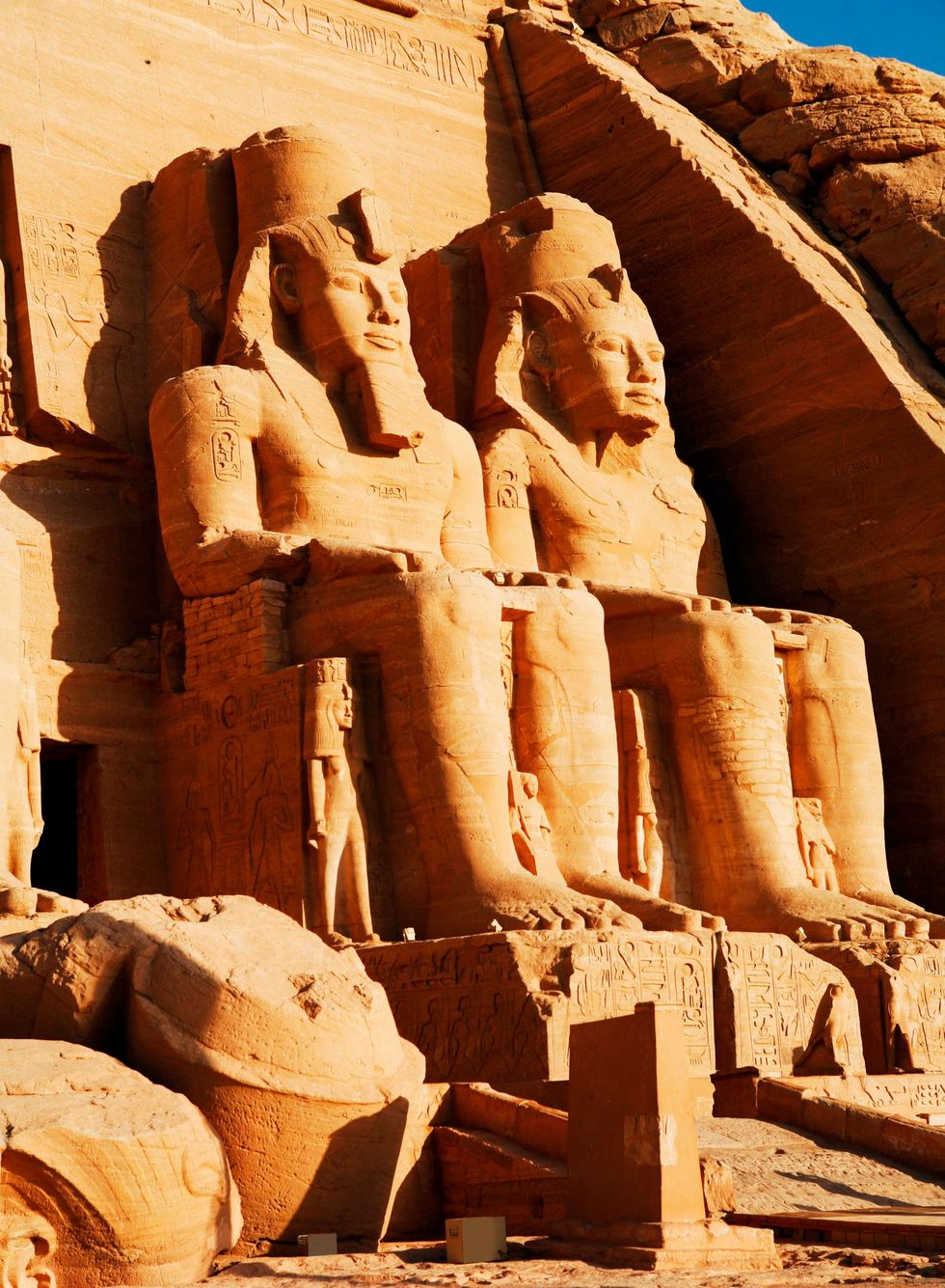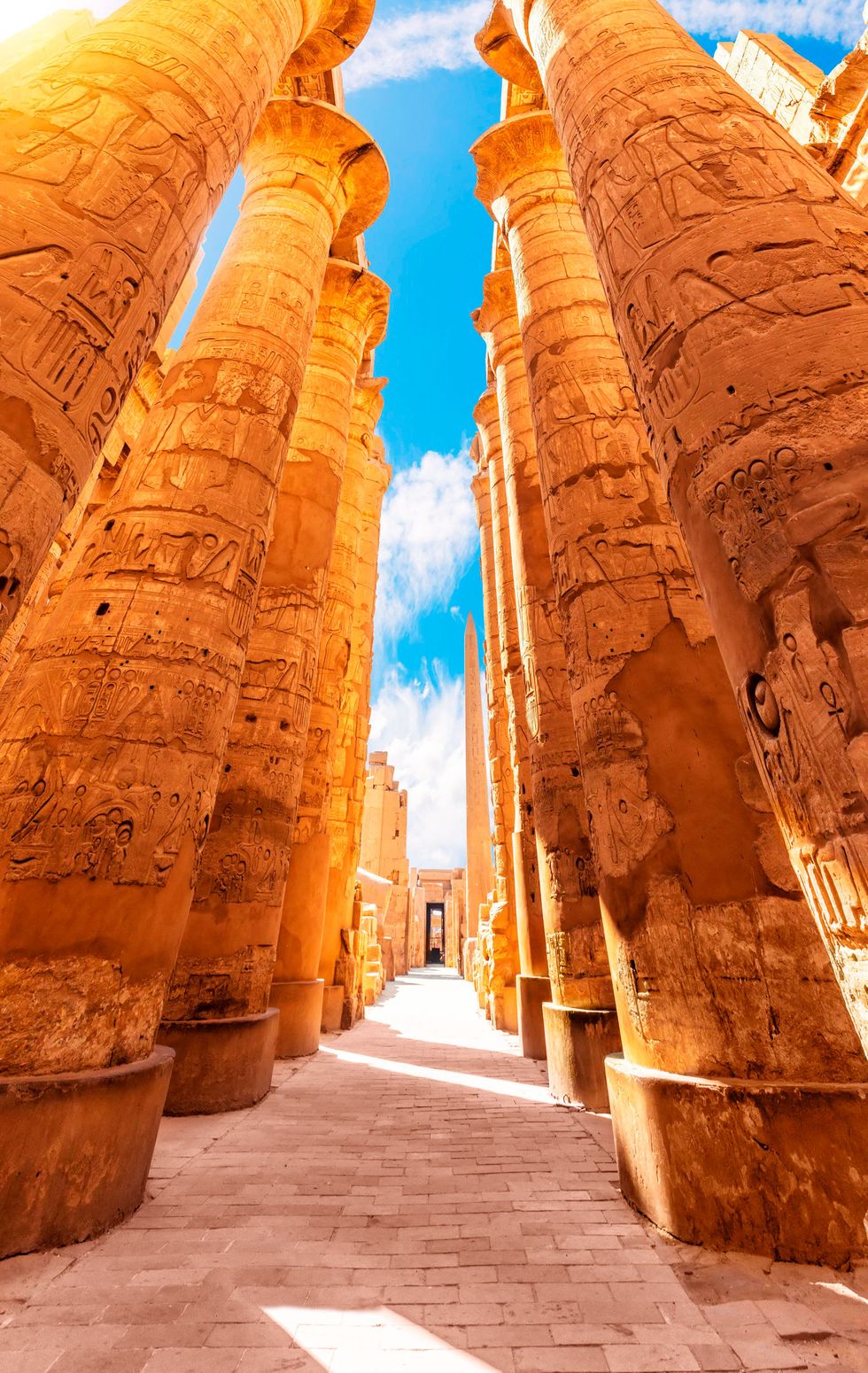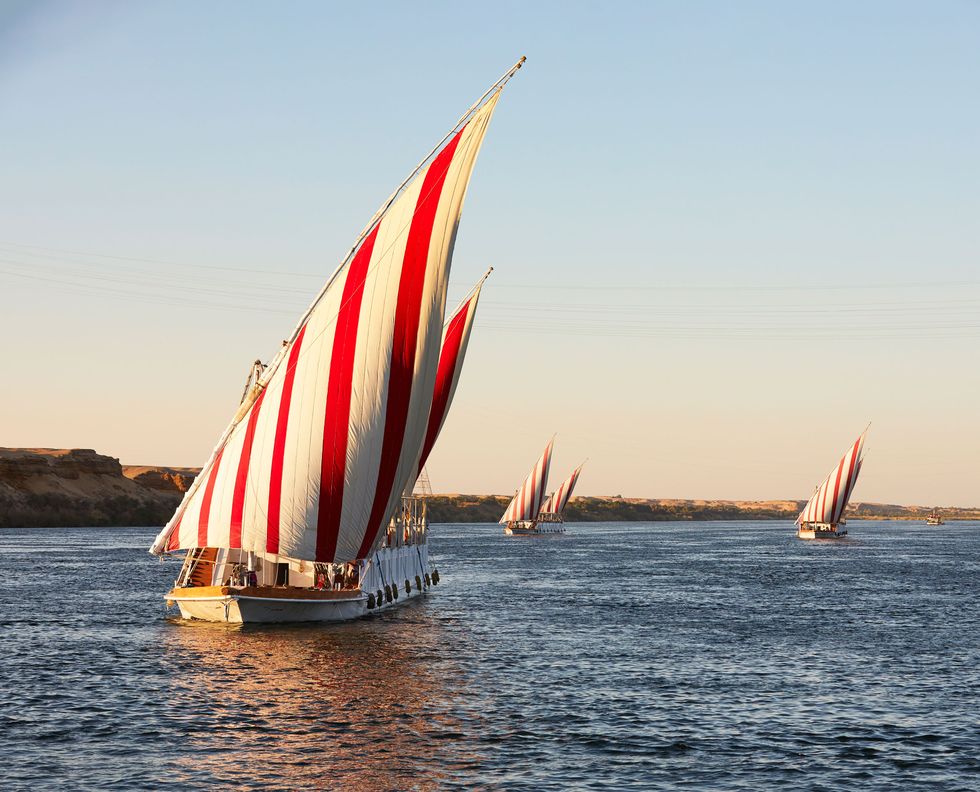Egypt gives us what no other country can: the chance to see up close, in situ, the astonishing creative impulses of the world’s most long-lived ancient civilization. If it’s your first time, you’ll want to concentrate on the historic must-sees. They are scattered the length of Egypt, mostly in the narrow band along the banks of the Nile. The classic itinerary is Cairo–Aswan–Nile cruise–Luxor, then back to Cairo. (The order of Aswan and Luxor can be switched, depending on which cruise you take.)
But Egypt has not been standing still. There are new museums. There is a fever of excavations, with new sites opening to visitors and others restored. And there are off-the-beaten-path places to explore, including the newly accessible Sahara oases (the desert makes up about 95 percent of Egypt’s territory and is another world). All that, however, requires that you extend your trip beyond the usual 10 to 12 days—or, unimaginably, skip one of the classic stops. Want a full day at the Old Kingdom necropolis of Sakkara, to see the new finds? You’ll need a third day in Cairo. Ditto if you’re a rider and want to spend an afternoon galloping on an Arabian horse around Sakkara and Giza.
The rarely visited but fascinating temples of Dendera (see page 61) and Abydos require a daytrip from Luxor. All this you should work out with a specialist travel adviser. Because no great Egyptian trip is ever DIY: Transportation (planes, cars, boats) needs to be seamlessly arranged, tickets need to be purchased and lines at museums and monuments negotiated, the best hotel rooms booked, and the services of top Egyptologist guides secured (not friends of the hotel concierge). I lived in Egypt, have traveled there multiple times, and still rely on James Berkeley of Destinations & Adventures International, who loves and knows Egypt intimately (jim@daitravel.com). As for timing, I’d say, counterintuitively, go in May, June, or early July. If you can tolerate the heat (or build in midday pooltime), it’s your best chance of seeing the monuments without hundreds of other people—the real holy grail of Egyptian travel. My other recommendations follow.
Cairo
You need at least two days in Cairo, more if you can. To stay, I recommend the Four Seasons Nile Plaza, the Ritz-Carlton, and, if you don't mind a slightly more four-star place, the Marriott on Cairo's central, formerly chi-chi Zamalek Island, where I always stay; I like its convenient location, its Suez-Canal-related history, and most of all its large back garden and buzzy outdoor cafe, where tout le Caire still seems to congregate over hookahs and mighty strong G&Ts.
Devote the first day to pharaonic Egypt: the pyramids of Giza and the Sphinx in the morning, followed by the Memphis Museum and a walkabout of the vast funerary complex of Sakkara. On day two you’re in medieval Islamic Cairo: two mosques (the renowned Al-Azhar and the magnificently severe Ibn Tulun), the Citadel (begun by Saladin to defend Cairo from the Crusaders), and an end-of-day meander (with shopping) around the Khan el-Khalili market—part tourist trap, part real thing. A third day can be some combination of the below:
New Musts
Two museums: The National Museum of Egyptian Civilization, where the mummies now reside, and the Grand Egyptian Museum in Giza, a.k.a., GEM (which is not officially open but is partially accessible, for a range of high fees—and worth it).
A full day at Sakkara: See the pyramid of Unas and its exceptionally fine carvings of funerary texts; the mind-bending Serapeum, where mummies of the sacred Apis bulls were buried in giant sarcophagi; and the king’s burial chamber tunnels beneath Djoser’s newly stabilized Step Pyramid; you can now gaze straight down at his sarcophagus. End the day at the rarely visited three main pyramids of Dahshur (the Red, Black, and Bent), seven miles south of Sakkara. This is what you want in Egypt: to see something no one else is seeing, alone with ancientness.
WISH LIST
For $3,000 you can spend time alone in Sakkara's colorful, newly discovered tomb of Wahtye, a high-ranking priest from the 25th century BC—who possibly stole the tomb from his brother.
Aswan
An early morning flight from Cairo to Aswan and a short connecting flight to Abu Simbel, near Egypt’s border with Sudan, puts you face to face with as great a play for immortality (and ancient geopolitical power) as the pyramids of Giza. Contemplate Ramses II’s two staggering temples, then board the short early afternoon flight back to Aswan and the luxuries of Sofitel Legend Old Cataract Hotel, with its ghosts of Winston Churchill, Agatha Christie, and many others—and the most perfect view of the Nile.
Aswan was always a frontier town, the last bastion of pharaonic religion, centered on the powerful cult of Isis worship in the temple of Philae. See the temple (it’s a tourist magnet, so go at dawn if possible), but even early travelers came here less for the antiquities than for the city’s tranquil “Nice of the Nile” beauty. Your next two days should include, between bouts of lounging, St. Simeon’s Monastery, in the desert on the opposite bank (the ancient Christian wreck has an oddly powerful aura); the elegant, eye-opening pink granite Nubian Museum (which presents the history and culture of Egypt’s ancient southern neighbor); Elephantine Island, a nexus of caravan routes from across Africa where you’ll arrive by felucca (an Aswan must); and a walk atop the Unfinished Obelisk, a fascinating ancient failure. Reputedly commissioned by the female pharaoh Hatshepsut, it would have been the world’s largest by far, but it developed fatal cracks. Its bottom end is still attached to the rock bed, workers’ marks still visible.
News
Foodie trove in the Aswan market: This small, manageable bazaar, which has rebounded in recent years, has the freshest, most varied spices procured directly from all over Africa. Stock up.
Luxor
This is the mother lode of Egyptian antiquities, the country’s ceremonial capital for millennia. Stay at the grand but tatty Sofitel Winter Palace, overlooking the Nile on the east bank, or the boutiquey, just renovated Al Moudira, amid farmland on the west bank. Musts on the east bank, site of the ceremonial temples: the Karnak complex, the largest place of worship in the ancient world, and Luxor Temple. On the west bank, site of mortuary temples and tombs, get advance special entrance tickets (fewer visitors) for a handful of the best pharaonic tombs in the valleys of the kings and queens—especially those of Ramses VI, Nefertari, and Seti I. See the stunning Deir el-Bahri, mortuary temple of Hatshepsut, at dawn, as crowds truly interfere with sightlines. The Tombs of the Nobles offer a glimpse of how nonroyals lived and died. The temples of Medinet Habu and the Ramesseum are much less crowded; the shattered remains of Ramses II’s colossal statue in the latter are a reminder of how man’s best-laid plans can come to naught.
News
Avenue of the Sphinxes: It took 70 years to restore this ancient road, originally lined with 1,057 sphinxes and ram-headed statues, and you can now walk its entire 1.7 miles, from Karnak to Luxor Temple.
Temple of Khnum, Esna: The long-overlooked temple of the ram-headed god, 35 miles south of Luxor, where most dahabiya cruises (see below) start, got a pharaonic face-lift; its columns now burst with their original colors.
WISH LIST
Luxor Temple is already resplendently lit at night. Now imagine a private dinner amid the forest of giant columns in its Hypostyle Hall. Jim Berkeley of DAI can arrange it for you.
Nile Cruise
Do not, under any circumstances, be talked out of a Nile cruise in Upper Egypt. I resisted for a long time, but once I succumbed I found out what I’d been missing. You can cruise on a largish ship, with amenities like a plunge pool and spacious cabins (best choices would be Oberoi’s Zahra and Philae, or Egyptian-owned Historia). Or, my preference: a traditional, flat-bottomed, two-masted dahabiya, with only eight to 12 cabins. Small cabins and bathrooms don’t matter, because you’re luxuriating on deck most of the time anyway, Agatha Christie–style, your hair blowing in the wind, a G&T in your hand, watching eternal Egypt pass by.
Consider one from chic Nour el Nil, which operates seven dahabiyas (the new Roman is the roomiest), or Zekrayaat, operated by Nile Dahabiya, or one from Lazuli Voyages. If you want total privacy, do a charter-only dahabiya, such as Zein Chateau, operated by A&K offshoot Sanctuary. Most commonly dahabiyas leave from Esna, south of Luxor, and sail four days upstream to Aswan. You can also board in Aswan and sail downstream, north to Esna—a shorter, 3-day voyage because of Nile currents. (How much time you spend on the boat will also determine in which order you visit Aswan and Luxor.) All ships stop at the temples of Kom Ombo and of Horus, at Edfu. But what only a dahabiya can offer is the ability to nose up to a pretty stretch of Nile shoreline and set up an impromptu picnic, after which you can walk to a nearby village where there are absolutely no other tourists.
News
Kazazian Cruises: It’s the striking new charter-only entrant in the Nile dahabiya competition. Their first boat can sleep 18, has a plunge pool on deck (as few others do), and has sleek all-white interiors.
Western Desert
Time in the desert gives any trip to Egypt an extra dimension. A vast region from west of the Nile to the Libyan border was closed for five years, because of instability in Libya, and only reopened recently. Fayoum oasis is just 69 miles southwest of Cairo, but it feels a world away: lush vegetation, waterfalls, a blue lake, rich birdlife (it’s on the migratory route between Africa and Europe). Fifty miles farther out is the Valley of Whales: gigantic fossils of whales and sharks from 40 million to 50 million years ago, when the Sahara was beneath the sea. (You will likely be alone.) Stay at the charming 16-suite Lazib Inn Resort & Spa, owned by a former VP of Four Seasons hotels.
Siwa oasis and its 40-room Adrère Amellal ecolodge, the inspired project of Cairo environmentalist and aesthete Mounir Neamatalla, require a 90-minute flight from Cairo or an eight-hour desert drive (which, believe it or not, has its charms). It is Egypt’s remotest oasis, a tropical garden of date palms, olive trees, and donkey carts, more than 200 freshwater springs, some hot, with the Great Sand Sea all around—the mammoth dunes of every Arabian fantasy, into which you can ride or drive. Visit the ruins of the temple of Amun, where Alexander the Great consulted the oracle in 331 BC after assuming the mantle of pharaoh, and the Mountain of the Dead, the startlingly beautiful graves of Siwa’s citizens going back to Greco-Roman times. Or just breathe, bathe, swim, and consume Adrère Amellal’s splendid organic meals—served at night by the light of hundreds of candles.
WISH LIST
There is not more glamorous takeover than Adrere Amellal. You'll need a solar charger for your phone, but you can say you've done the "Sahara roller coaster" and slept where King Charles did.
This story appears in the Summer 2023 issue of Town & Country. SUBSCRIBE NOW

Klara Glowczewska is the Executive Travel Editor of Town & Country, covering topics related to travel specifically (places, itineraries, hotels, trends) and broadly (conservation, culture, adventure), and was previously the Editor in Chief of Conde Nast Traveler magazine.
